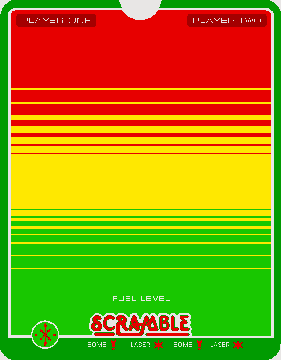
Computer Nerd Kev |
Home|About|Projects|Links |
Home > eOverlays |
Vectrex Electric Overlays |
The "Vectrex" video game system from the 1980s, noted for its black and white vector display, used coloured plastic "overlays" to colour the white lines it drew on its screen. A prototype colour Vectrex was produced, but the design never saw production.
Here is an overlay:

New overlays were sold with each game, but they easilly parted company with their matching game cartridges before being handed on to the later generation of owners who use the system today. In short, there are a lot of Vectrex games and gamers stuck in the monochrome world of mid-eighties Vector display technology, without even a piece of coloured plastic to clasp at.
And so the idea occoured to me that another display technology could be used to fiddle with Vector light, and provide a single anwser to the eternal overlay quest. The colour LCD display, I realised, was in fact an electric overlay:
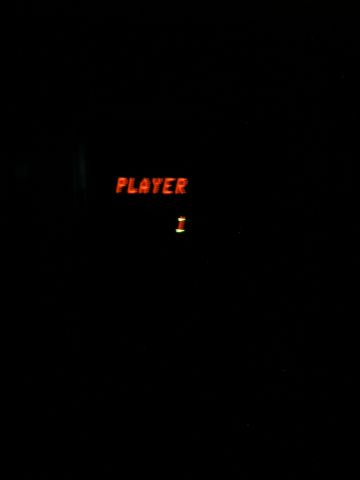
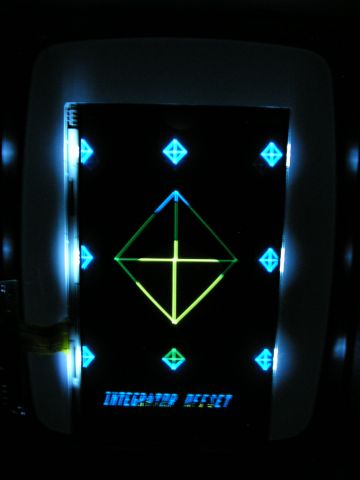
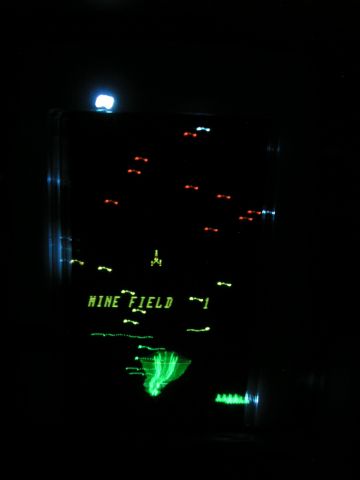
What you can see is a Vectrex screen through an ex digital photo frame's LCD display, unfortunately I was too cheap to buy one that covered more of the screen. The white LED backlight was removed (surprisingly easilly) so that it just acts as an active colour filter for whatever light appears behind it. The photo frame's control circuitry was connected by quite a short cable, so it had to sit right next to the LCD panel, the electronics are small enough though that they sat quite nicely.
Here's the set-up:
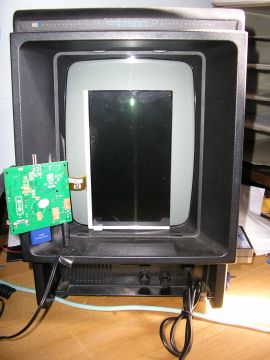
In normal room lighting, the display is a bit dim, but viewable with the brightnes set near full on the Vectrex. It's possible that lower resolution screens would allow more light to pass through, and high resolutions wouldn't be required in this application. The LCD used was a 480 x 234 (according to the photo frame's specifications) TFT, it's possible that lower resolution displays are not made, but an STN type LCD display should allow more light to pass through.
The display is very sharp through the LCD.
When black is displayed on the screen, it appears to fully block light from the Vectrex screen in areas where it is present.
The screen without the backlight etc. is actually thin enough to fit in the overlay slots, though it can't be flexed to be inserted like a standard overlay.
Artwork around the edges of the overlays is completely invisible unless parts are illuminated by graphics displayed by the Vectrex. Selective illumination of areas would be possible, but plastic diffusers would have to be specially manufactured in the correct shape, to direct light from LEDs to only the edges. The gap between the LCD and the Vectrex screen caused by the diffusers could reduce the sharpness of the Vectrex picture.
Unless selective backlighting is used, as described above, a second display will have to be used show which overlay image file has been slected. There is no visibility through the LCD when light is not emitted by the Vectrex display.
The old LCD backlight should make a good slide viewer :)
The digital photo frame used was a "Thomson DF1707" 7" 16:9 TFT display with a resolution of 480x234, it displays GIF images fine even though the manual says it only supports JPEG. I believe the Vectrex screen size is close to 10" 4:3, though I haven't tested how well a rigid board of this size would fit in the screen area.
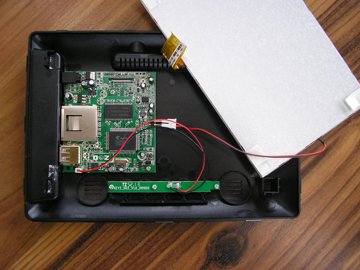
The photo frame case was separated by prying the plastic apart with a screwdriver. The metal casing around the LCD display was removed by bending the metal clips apart and separating the two halves. The LCD panel could then be easilly parted from backlight assembly.
Using control electronics with controls and display able to be placed away from the Vectrex, and read image files from a removable memory device, a suitably sized colour LCD panel could be used as an electronic overlay replacement.
Given a communication method between the Vectrex and the LCD control electronics, some amount of interactivity may be possible between the game and the display colouring. Ideally real-time colouring of game objects would be possible (note the invisibility of the full overlay image to the user would allow very low resolutions to be used). - Re-inventing the colour Vectrex!
If game interactivity is possible as described above, the use of Black colouring on the LCD display could hide areas so as to allow more complex visuals to be displayed without excessive flicker. Of course this may require higher resolutions and update times in some circumstances than required for simple colouring of the image.
An LCD panel is able to be used as an effective method of adding colour to the display of the Vectrex. Some improvements may be possible in the brightness of the display, but the display is viewable in normal lighting with the LCD panel used in these tests. However to enable the viewing of overlay boarder art, significant manufacturing complexity is introduced by the backlighting requirements.
The possibility of game interaction may allow an expansion in game display capabilities without requiring modification to the Vectrex console. The extent of this depends largely on the I/O options able to be exploited on the Vectrex and the methods available for specifying images on the display.
Here are a couple of short videos I took using my digital camera. It doesn't do low light video very well unfortunately, in particular Red seems not to show very well, so where things disappear they probably turned Red.
I might be able to make a better video in the future, but will have to set some stuff up first.